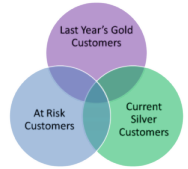 Do you have an old leather jacket? You know the kind. The jacket that reminds you of the good old days. Each time to try it on, it fits so perfectly, you wonder why you don’t get it out more often. It’s tough, it’s cool, it’s unique, and everyone should have one. When I bring it out and show the kids – they love it.
Do you have an old leather jacket? You know the kind. The jacket that reminds you of the good old days. Each time to try it on, it fits so perfectly, you wonder why you don’t get it out more often. It’s tough, it’s cool, it’s unique, and everyone should have one. When I bring it out and show the kids – they love it.
Well, from a software perspective, my “old leather jacket” is Set Analysis. I recently had a situation where a customer needed the capabilities of Set Analysis in their organization to solve some specific reporting needs. I had to dust off the manuals and fire it back up again, but when I did, I wondered why we’d been apart so long.
Set Analysis is a product that was created by Next Action and was acquired by Business Objects way back in October of 1999. Business Objects then launched a company called Ithena, which created analytic application and use set analysis extensively. I provide this background to let you know that the Set Analysis product has been around for a long time and it still brings value today.
Set Analysis provides ability to categorize information. The fancy term for this is called segmentation and is typically market or customers segmentation (although it also can relate to products, employee, etc.) This capability is critical to help organizations understand how the customers and products are affecting their business. We use collections, or sets, to make lists of items to communicate and to manage.

In this Venn diagram you can see there are three sets:
- Last year’s gold customers
- Current silver customers
- Customers at risk
Segmentation products let Set Analysis make it easy to pick where you want to focus. For example the light green area represents the collection of: Last year’s gold customers who are at risk but are not currently silver.
Here is another example related to mortgage providers:
- Customers who have a good credit rating
- Customers who are paying an above average interest rate
- Customers who have not refinanced in the last 24 months.
- Customers who have never made a late payment.
Customers who exist in a set are called members.
Next, a mortgage company might take all four collections and market those customers who are members of all four sets with the goal of offering them a more competitive interest rate before they shop their mortgage with a competitor.
So what’s the big deal?
I hear what you are saying. What is the big deal? That’s just a normal query and you are right it is. What is facinating is the ability within a sets engine like Set Analysis to see the trends in these sets over time. Although it’s possible to get a snapshot of these collection members through a standard database query, what you don’t see is changes to the sets over time. For example you need to know:
- How many Platinum Customers do I have? 1,000.
- If I had 900 last month, did I have 100 join or did I have 200 new customers join and 100 leave?
- Where did they go? Did they become Gold? Silver? Are they off the radar?
It’s fascinating to me to see how organizations are so focused on what they sell and yet there is so much value in looking at what you didn’t sell… and who you didn’t sell it to!
In a down economy like we see today, it seems even more important than ever before to understand what your customers are doing.
In the next few posts, I’ll take a little bit of a deeper dive into the product and share a few tricks and tips.

Thanks for writing about Set Analysis. It’s one of those Business Objects products of which you know its existance, in my case through installing BusinessObjects Enterprise with partner keys, but you’re never quite sure how to configure it, let alone use it.
As a BI consultant I think that it could potentially be an application that customers have a definite need for, but up until now I wasn’t sure how to explain the concept(s) to them. Now, with your posts and the e-learning I found on the partner site I’m quite confident I’ll get the hang of it.
I noticed that though that Ithena no longer exists. What’s the story behind that?
Glad to be of service and thanks for letting me know it was useful. Ultimately the team from Ithena became part of the BusinessObjects family. Although Ithena doesn’t exist as a separate entity, you can find some of those folks by searching business networking sites like LinkedIn.
You simply solved my troubles. I am a BI consultant for more than 6 years now and since been using BO for as long as i can remember. I have just completed my masters degree in informatics and being interested in data mining. And know i have found the appropiate tool to traing my data sets